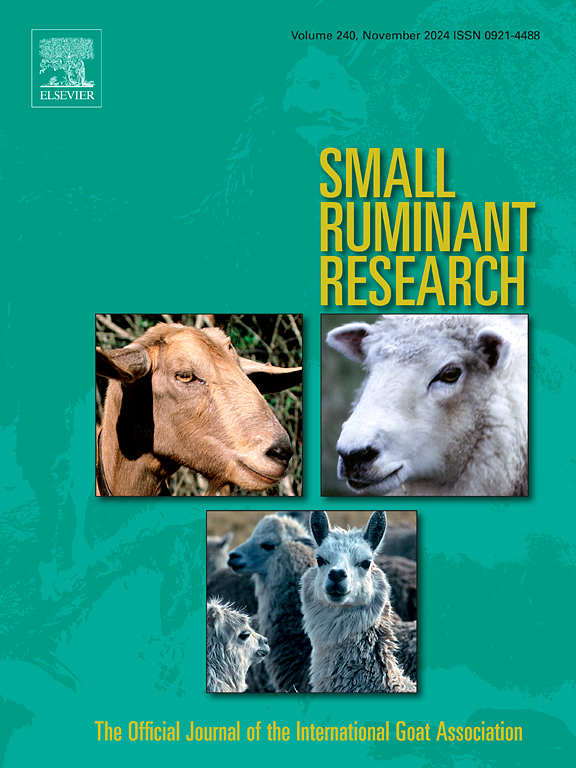半干旱地区本地羊与外来羊杂交项目中羔羊的存活率和母羊的寿命
IF 1.4
3区 农林科学
Q2 AGRICULTURE, DAIRY & ANIMAL SCIENCE
引用次数: 0
摘要
羊群中羔羊的存活和母羊的寿命对绵羊种群的可持续性非常重要,特别是在干旱和半干旱地区。本研究采用Cox和Weibull比例风险模型,对本地纯红马赛(RRRR)、纯杜珀(DDDD)及其F1 (DDRR)和75% %杜珀-25 %红马赛(DDDR)杂交羔羊断奶前和断奶后的存活率和母羊寿命进行了分析。目的是确定影响羔羊存活至一岁以及母羊寿命的遗传和非遗传因素。数据包括6313只羔羊和2003只母羊的记录。总体断奶前死亡率(5 %)低于断奶后死亡率(17 %)。在漫长的旱季出生的羔羊比在雨季出生的羔羊死亡的风险更高。无论是羔羊还是母羊,杜珀羊死亡或被扑杀的风险都最高。杂交品种中,DDDR羔羊和母羊死亡或被淘汰的风险高于F1羔羊和母羊。母羊被淘汰的风险随着初产和胎次的增加而降低。断奶前死亡率的遗传力估计(0.10-0.14)高于断奶后死亡率(0.01-0.05)。断奶前羔羊存活率较高的遗传率表明遗传变异较大,为羔羊存活率的选择提供了机会。改善ASAL地区生产环境的干预措施也将提高羔羊的存活率和母羊的寿命。本文章由计算机程序翻译,如有差异,请以英文原文为准。
Lamb survival and ewe longevity in a crossbreeding program between indigenous and exotic sheep in semi-arid lands
The survival of lambs and longevity of ewes within flocks are important for the sustainability of sheep populations especially in arid and semi-arid lands (ASAL). In this study we conducted pre- and post-weaning survival analysis of lambs and the longevity of ewes of indigenous pure Red Maasai (RRRR), pure Dorper (DDDD), and their crosses comprising F1 (DDRR) and 75 %Dorper-25 %Red Maasai (DDDR) using Cox and Weibull proportional hazard models. The objective was to determine the genetic and non-genetic factors affecting lamb survival to yearling as well as ewe longevity. Data comprised records on 6313 lambs and 2003 ewes. Overall pre-weaning mortality was lower (5 %) compared to post-weaning mortality rate (17 %). Lambs born during the long dry season had a higher risk of dying than those born during the wet seasons. For both lambs and ewes, the Dorper had the highest risk of dying or being culled. Among the crossbreds, the DDDR lambs and ewes had higher risks of dying or being culled relative to F1 lambs and ewes. The risk of ewes being culled reduced with increasing age at first lambing and parity. Heritability estimates for pre-weaning mortality were higher (0.10–0.14) than post-weaning mortality (0.01–0.05). The higher heritability for pre-weaning lamb survival in indicates greater genetic variation, presenting an opportunity for selection for lamb survival. Interventions to improve the production environment in the ASAL areas would also improve the survival of lambs and longevity of ewes.
求助全文
通过发布文献求助,成功后即可免费获取论文全文。
去求助
来源期刊

Small Ruminant Research
农林科学-奶制品与动物科学
CiteScore
3.10
自引率
11.10%
发文量
210
审稿时长
12.5 weeks
期刊介绍:
Small Ruminant Research publishes original, basic and applied research articles, technical notes, and review articles on research relating to goats, sheep, deer, the New World camelids llama, alpaca, vicuna and guanaco, and the Old World camels.
Topics covered include nutrition, physiology, anatomy, genetics, microbiology, ethology, product technology, socio-economics, management, sustainability and environment, veterinary medicine and husbandry engineering.
 求助内容:
求助内容: 应助结果提醒方式:
应助结果提醒方式:


